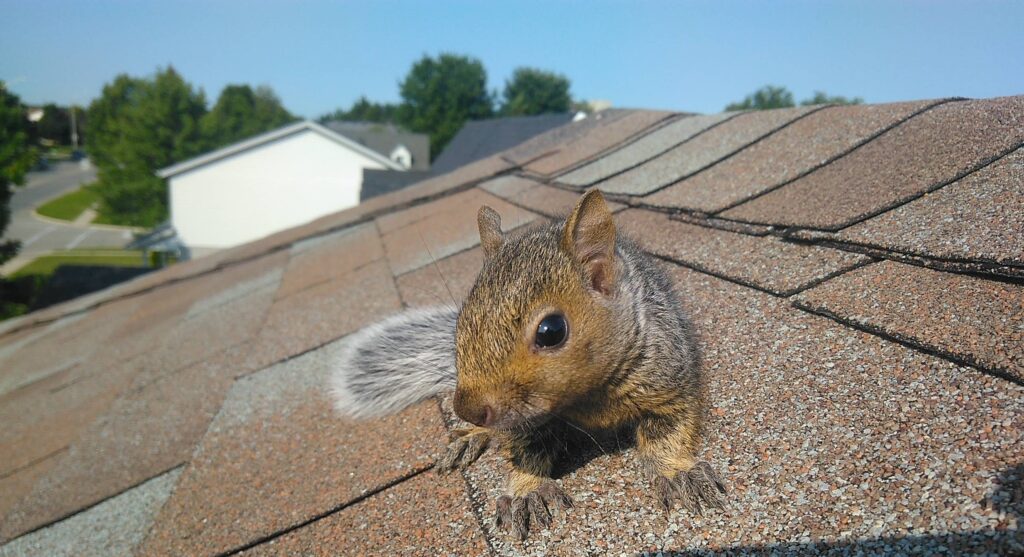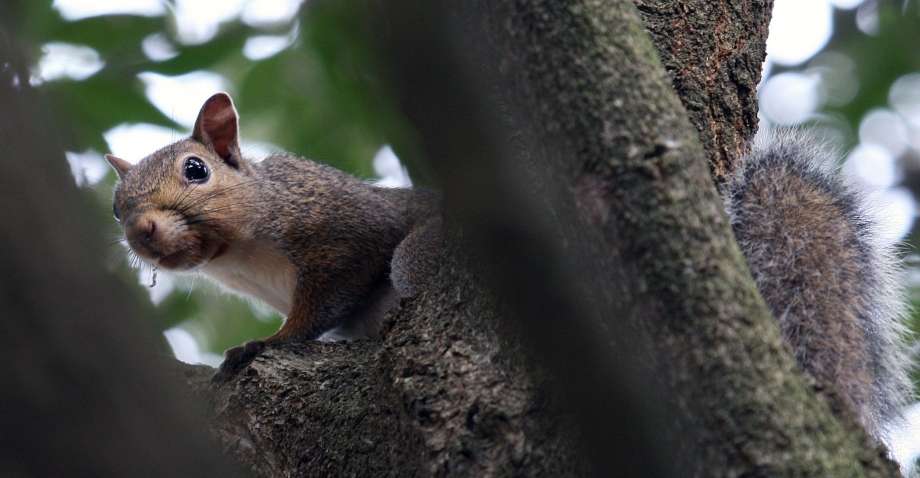In Oak Grove, it’s not uncommon to spot squirrels engaging in their characteristic antics amidst the lush foliage. One curiosity that often piques the interest of residents is the sight of squirrels relentlessly chewing on tree bark and branches. But what drives this seemingly destructive behavior? The answer lies in the natural habits and necessities of these agile little animals.
Squirrels chew on trees for several reasons that are crucial for their survival and well-being. This behavior helps them to maintain their ever-growing teeth, ensuring they don’t become too long and hinder their ability to eat. Tree bark and branches are also sources of essential nutrients. Furthermore, gnawing on trees aids in nest-building by providing materials and creating cavities for shelter.
Understanding these behaviors is vital for effective wildlife management. Skedaddle Humane Wildlife Control in Oak Grove specializes in addressing such issues with a compassionate approach. Throughout this blog, we will delve into the intricate reasons behind squirrel-eating habits, explore their dietary needs, and highlight the humane removal techniques employed by experts to manage these furry residents responsibly.
The Nature of Squirrels
In Oak Grove, we live alongside playful creatures like the Eastern gray squirrel and the rare black squirrel. They both have sharp claws for climbing and bushy tails for balance and warmth. Gray squirrels are more common, with gray fur mixed with brown, while black squirrels have a dark coat.
Squirrels go through several life stages, each with distinct behaviors and needs. From birth to around eight weeks, squirrel pups are dependent on their mother’s nourishment and protection. As they grow and gain independence, typically around 10 to 12 weeks, they begin to explore and learn survival skills, including foraging for food. It is the younger, more adventurous juveniles, still honing their skills, who are most frequently seen engaging in chewing activities to keep their teeth in check and to gather materials. Adult squirrels, while still active, are more experienced and focused on sustaining their territories and raising their young.
Throughout our wildlife management efforts, understanding these stages helps us implement humane techniques tailored to the specific needs of local squirrel populations. This knowledge ensures that we manage their presence in Oak Grove responsibly while minimizing the impact on the area’s natural ecosystem.

Reasons Behind Tree Chewing
In our exploration of squirrel behavior in Oak Grove, it’s clear that chewing on trees is more than just a quirky habit. This activity serves specific and essential purposes for these agile animals, stemming from their need to maintain dental health and meet nutritional requirements.
Dental Health: One primary reason for this tree-chewing behavior is dental health. Like other rodents, squirrels have teeth that continuously grow throughout their lives. If these teeth aren’t worn down regularly, they can become overly long, making it difficult for the squirrels to eat and potentially causing other health issues. Chewing on tree bark and branches provides the necessary abrasion to keep their teeth at a manageable length.
Nutritional Needs: Beyond dental maintenance, trees also offer nutritional benefits. Chewing on certain trees allows squirrels to access sap, which contains essential nutrients. This additional nutrient source is particularly beneficial during times when other food supplies may be scarce.
Squirrels often target specific trees like maples and oaks. Maples are particularly attractive because their sap is rich in sugars, providing a quick energy boost. Oaks, on the other hand, offer hearty bark and branches that are ideal for both chewing and nest-building.
Potential Risks to Trees
While observing squirrels as they engage in their tree-chewing activities can be fascinating, it’s essential to consider the potential risks this behavior poses to tree health. The consequences extend beyond mere superficial damage and can have profound long-term impacts on the vitality of our beautiful urban canopy.
When squirrels chew on tree bark, they strip away layers essential for the tree’s protection. This damage can expose the inner wood to elements and pathogens, increasing the likelihood of infections. Open wounds on trees serve as perfect entry points for fungi and bacteria, potentially leading to decay and disease. Additionally, repeated gnawing can weaken tree structure over time, making branches more susceptible to breaking during storms or heavy winds. The long-term effects of persistent chewing damage can stunt a tree’s growth, affect its ability to transport nutrients effectively, and may even lead to premature death. The loss of bark disrupts the tree’s vascular system, impeding the flow of water and essential nutrients. Consequently, affected trees often exhibit slower growth rates, diminished foliage, and increased susceptibility to environmental stresses.
By understanding these impacts, we can better appreciate the importance of humane wildlife management and the role it plays in maintaining a balanced ecosystem.
Why Professional Intervention is Necessary
At Skedaddle Humane Wildlife Control, we pride ourselves on adopting a compassionate and effective approach to managing wildlife issues, particularly those involving squirrels. Understanding the unique chewing habits and nutritional needs of these animals has guided us in developing methods that ensure their well-being while protecting the trees and properties in Oak Grove.
One of our key humane techniques involves the use of specially designed two-way doors. These devices allow squirrels to exit safely while preventing them from re-entering. Unlike harmful relocation practices that disrupt their established territories and family structures, two-way doors provide a respectful and efficient solution. When a squirrel leaves its nesting area through these doors, it cannot return, encouraging it to relocate naturally within its environment. This method not only protects the animals but also minimizes the stress and potential harm that forced relocation can cause.
Our commitment to the community and the local ecosystem is reflected in every aspect of our service. From the initial assessment to implementing exclusion techniques and follow-up visits, we strive to address the needs of both the wildlife and residents of Oak Grove. Our humane methods aim to manage these industrious creatures without causing unnecessary harm, ensuring a harmonious coexistence.
Dangers of DIY Control
Taking on DIY control methods for dealing with these local animals can be fraught with risks to both the creatures and humans involved. While the intent may be to manage the situation independently, without professional expertise, the consequences can range from ineffective results to significant harm.
- Injury to Animals: Without the proper equipment and training, attempting to handle these creatures can inadvertently cause injuries. Improper trapping or handling techniques can lead to broken limbs, severe stress, and even death.
- Human Safety Risks: Handling such tasks without professional training increases the risk of bites and scratches, which can lead to infections. Additionally, these animals can carry diseases that are transmissible to humans, making direct contact hazardous.
- Inadequate Resolution: DIY methods may provide temporary relief but often fail to address the root of the issue. Ineffective solutions can lead to repeated invasions, further exacerbating the problem.
- Legal and Ethical Concerns: Certain methods may inadvertently violate local wildlife protection laws, resulting in legal ramifications. Ethically, improper removal techniques can cause unnecessary suffering to the animals.
Recognizing these dangers underscores the importance of entrusting such tasks to our skilled professionals. At Skedaddle Humane Wildlife Control, our approach ensures the safety and well-being of both the animals and the residents, fostering a cooperative and balanced ecosystem.
Preventative Measures and Solutions
As homeowners, there are several proactive steps we can take to discourage the chewing habits of local wildlife and safeguard our trees. Implementing these measures helps protect our outdoor spaces while promoting a healthy ecosystem.
One effective way to deter animals is by installing protective wraps or guards around the trunks of young trees. These barriers, made from materials like mesh or plastic, shield the bark from damage and prevent access to the tender wood beneath. Another strategy involves the careful placement of feeders to draw attention away from the trees. By positioning feeders with appealing food sources in locations distant from vulnerable plants, we can reduce the likelihood of animals chewing on tree bark.
By adopting these strategies, we not only protect our greenery but also ensure a respectful interaction with the surrounding wildlife. For more comprehensive solutions, Skedaddle Humane Wildlife Control is here to assist in creating a balanced environment for all.
Understanding the chewing and eating habits of squirrels is essential to preserving your trees and property. Do squirrels chew on trees? Yes, they do, but with Skedaddle Humane Wildlife Control’s expert help, you can effectively manage this behavior. Our compassionate approach ensures the well-being of squirrels while providing robust protection for your property.
Contact us today to request a quote and learn more about how we can assist you in preserving your serene environment.



